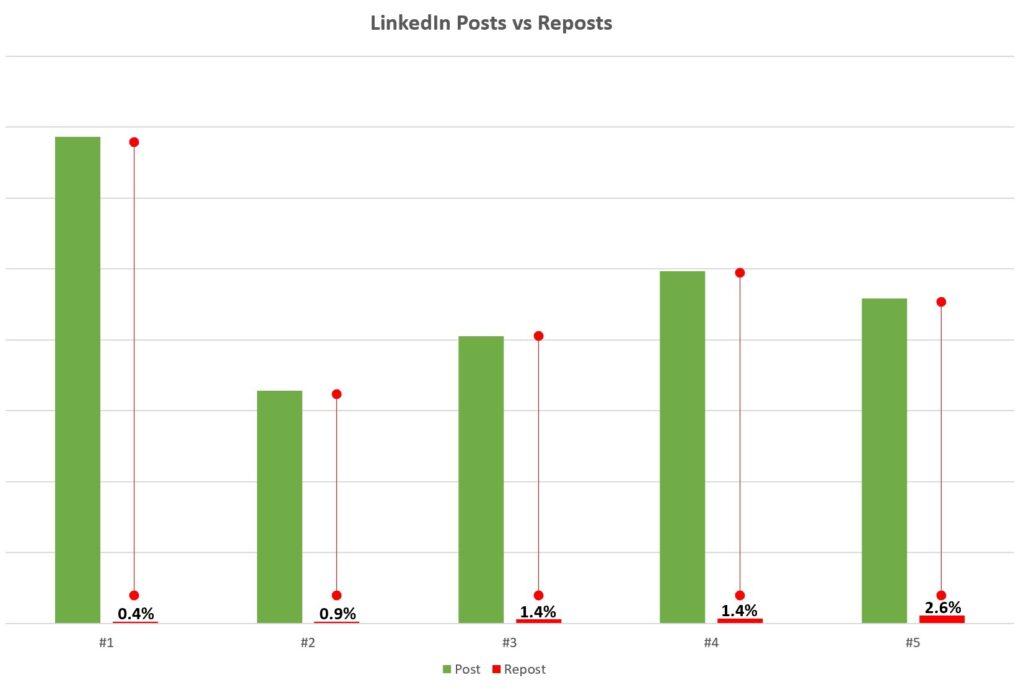
Today I want to help you avoid one of the most common ‘performance killers’ on LinkedIn.
It’s a tactic used by every executive I talk to, but none are aware of just how bad it is…
The truth is: reposting on LinkedIn shoots your content in the foot.
I’m determined to help executives use LinkedIn to amplify good leadership.
As a part of that, I want every one of your messages to count. So I’m going to share a few better, more effective approaches you can adopt instead of reposting.
While the practice is rife across LinkedIn, it’s often only due to restrictive social media policies, or executed unknowingly with the best of intentions.
But it doesn’t work. Here’s just one example that highlights the problem.
A client of ours recently published a post. It got a fairly moderate number of impressions – a few thousand. Nothing outrageous, but a fair result.
That same post was then reposted by a colleague.
The result?
Almost 250x less reach on the repost.
And this wasn’t a once off. I looked at the stats across five examples and the results were all similar.


Think about that for a moment. For every one person reached via the repost, they could have reached nearly 250 more with an original piece of content…
In fact, when I dug deeper, I found no less than 22 other reposts that had zero impressions between them.
Even one executive with a network of 10,000 people generated just 59 impressions on one of their reposts.
These are massive differences. Particularly when every leader wants to find ways to cut through the noise today.
So, if reposts don’t work, why do executives use them?
Apart from restrictive social media policies, let’s look at a few other common scenarios.
1. Someone you respect – within or outside your organisation – posts something you love, and you want to ensure they get the recognition;
2. ‘The key authority’ (e.g. the brand, CEO, Chair) makes a major announcement, and you want to support them without stealing the limelight; or
3. For job opportunities, you want to funnel all interest to the person posting the ad – often in People & Culture or the Talent Acquisition team.
On the surface, all these reasons make sense.
But, when you know how poorly reposts perform, a tension emerges between your initial intent and the ultimate outcome.
The good news? There are far better ways to respect protocol, hierarchy or good-old-fashioned manners without sacrificing performance.
What do I recommend instead?
Here are two simple alternatives that will yield MUCH stronger results:
1. Comment on the post. Consider the post through your lens (the role you have, issues you care about, people in your network etc). Write a comment under the post that extends the initial thinking in your own way to both add value to the original post, and to invite your network into the discussion; or
2. Tag or share privately. Think about who in your network will be really interested in the post or have an opinion on the topic. Then either:
Tag that person in a comment (the @ symbol), along with a prompting statement for why you think they’ll be interested; or
Send the post to them privately (the paper aeroplane icon) so you can share more context, respect their privacy, and still alert them to the post.
Both the above options are great ways to ‘cross-pollinate’ networks as a leadership team. And both these approaches are best practice.
But I appreciate it may mean having a few conversations with the powers that be, or reviewing your current social media policy.
Despite this, these conversations are still well worth starting if the outcome matters more than ‘box ticking’ to you. Otherwise, you risk wasting your time and effort on LinkedIn vs having a real impact online.
Drop me a note if you get stuck or would like to discuss how to change the way you operate. Particularly for detailing which leaders own what topics on LinkedIn, or refining social media policies – we’ve done this work many times before and I’d be happy to share learnings.
Take care in the meantime,
Roge

Want more just like this delivered straight to your inbox? Subscribe below for all your latest digital reputation advice, trends and the best practice examples of the leaders getting it right online. We’d love to have you part of this growing community.